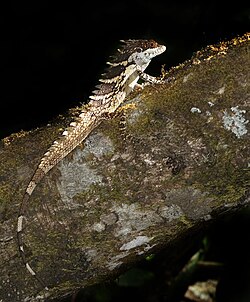Salea
| Den här artikeln har skapats av Lsjbot, ett program (en robot) för automatisk redigering. (2013-02) Artikeln kan innehålla fakta- eller språkfel, eller ett märkligt urval av fakta, källor eller bilder. Mallen kan avlägsnas efter en kontroll av innehållet (vidare information) |
| Salea | |
 | |
| Systematik | |
|---|---|
| Domän | Eukaryoter Eukaryota |
| Rike | Djur Animalia |
| Stam | Ryggsträngsdjur Chordata |
| Understam | Ryggradsdjur Vertebrata |
| Klass | Kräldjur Reptilia |
| Ordning | Fjällbärande kräldjur Squamata |
| Familj | Agamer Agamidae |
| Släkte | Salea |
| Vetenskapligt namn | |
| § Salea | |
| Hitta fler artiklar om djur med | |
Salea[1] är ett släkte av ödlor. Salea ingår i familjen agamer.[1]
Kladogram enligt Catalogue of Life[1]:
| Salea |
| ||||||||||||
Källor
- ^ [a b c] Bisby F.A., Roskov Y.R., Orrell T.M., Nicolson D., Paglinawan L.E., Bailly N., Kirk P.M., Bourgoin T., Baillargeon G., Ouvrard D. (red.) (13 januari 2011). ”Species 2000 & ITIS Catalogue of Life: 2011 Annual Checklist.”. Species 2000: Reading, UK. http://www.catalogueoflife.org/annual-checklist/2011/search/all/key/salea/match/1. Läst 24 september 2012.
Externa länkar
|
Media som används på denna webbplats
Robot icon
Författare/Upphovsman: Praveenmac, Licens: CC BY-SA 3.0
Snout long, measuring nearly twice the diameter of the orbit; tympanum 1.6 times the diameter of the orbit; upper head-scales rather large, feebly keeled, with a regular curved series of enlarged scales bordering the supraorbital region internally: an enlarged tubercle behind the supraciliary edge and a few others scattered on the back of the head; a row of 3 or 4 enlarged scales from the eye to above the tympanum. Gular scales a little larger than ventrals, smooth or keeled. A well-marked curved fold on each side of the neck, in front of the shoulder. Dorso-nuchal crest continuous, composed of large lanceolate spines. Dorsal scales of unequal size, their arrangement varying considerably, strongly keeled, the upper ones pointing upwards and backwards, the others straight backwards or backwards and downwards; ventral scales very strongly imbricate, strongly keeled, and ending in a spine. The adpressed hind limb reaches the neck. Tail strongly compressed, in its anterior half with an upper crest nearly as much developed as the dorsal; caudal scales rather unequal in size, keeled, rale olive above, with 4 broad angular dark-brown cross bands on the back, separated by narrow interspaces; head to the lip dark brown, with small light spots; limbs and tail with more or less regular dark-brown cross bars.praveen Dwarkanath.[1]
From snout to vent 4.3 inches.